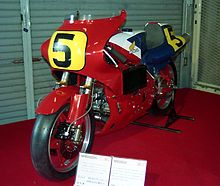- Honda NR500
-
NR500 was an innovative racing motorcycle developed by Honda HRC in 1979 to compete in Grand Prix motorcycle racing. The NR stood for New Racing.[1]
The motivation behind the NR500 was company founder Soichiro Honda's desire to compete using four-stroke engine technology since the majority of motorcycles manufactured by Honda used four-stroke engines. When the FIM announced new regulations for the 1968 Grand Prix motorcycle racing season that limited the 500 cc engines to four cylinders, this gave an advantage to teams using two-stroke machinery. Honda decided to withdraw from motorcycle racing to concentrate on its automobile division.[2]
In November 1977 Honda announced it would be returning to motorcycle Grand Prix racing using four stroke technology.[2] Even though two-stroke engines dominated motorcycle Grand Prix racing in the late 1970s, Honda felt bound by their convictions to race what they sold and thus decided to compete using a high-technology, four-stroke race bike.[3] Since a conventional four-stroke, four-cylinder engine could not produce the same power of its two-stroke rivals, Honda had to increase the valve area in order to be competitive.[4] The rules at the time allowed up to four combustion chambers so Honda designed a 32 valve V8 with four pairs of linked combustion chambers. This then evolved into an innovative engine with four oval-shaped cylinders. The oval cylinders allowed room for 32 valves and eight spark plugs, the same as that of an eight-cylinder engine while staying within the four cylinder rules limit. Another innovation used on the NR500 was its monocoque body which wrapped around the engine like a cocoon and helped reduce weight.[5] In an effort to reduce drag, the bike also used 16-inch wheels instead of the mainstream 18-inch versions.
Honda overcame significant manufacturing problems to develop its oval cylinder technology and by late 1979 the bike made its much-anticipated debut at the British Grand Prix ridden by Mick Grant and Takazumi Katayama. Both bikes retired, Grant crashing out on the first turn after the bike spilled oil onto his rear tire. Katayama retired on the seventh lap due to ignition problems.[6] Honda persevered for two more seasons but never managed to make the bike competitive.[7] The monocoque frame had to be abandoned because it made it too difficult for mechanics to work on the engine during races. The 16-inch wheels also had to be abandoned for 18-inch wheels.[8] American Freddie Spencer was able to reach 5th place at the 1981 British Grand Prix before the bike broke down. The NR500 never managed to win a Grand Prix, a thirteenth place by Katayama at the 1981 Austrian Grand Prix being its best showing.
Honda decided to abandon the project and designed the NS500 two-stroke bike to compete in the 1982 season.[9] Spencer would ride the NS500 to Honda's first 500 cc world championship in 1983. Ultimately, what doomed the NR500 project was that Honda had tried to develop too many technologies at one time. The NR500 did experience a few successes. Freddie Spencer rode the NR500 to a heat race victory at Laguna Seca in 1981 and Kengo Kiyama won the Suzuka 200 kilometer race that same year.[10]
References
- ^ http://world.honda.com Part 3
- ^ a b http://world.honda.com Part 2
- ^ http://world.honda.com Part 4
- ^ http://world.honda.com Part 5
- ^ http://world.honda.com Part 7
- ^ http://world.honda.com Part 8
- ^ Mick Walker's Japanese Grand Prix Racing Motorcycles, by Mick Walker, Publisher Redline Books, 2002, ISBN 0953131181, 9780953131181
- ^ http://world.honda.com Part 9
- ^ http://world.honda.com Part 11
- ^ http://world.honda.com Part 10
500cc 350cc RC170, RC171, RC172, 2RC172 • RC173 • RC174250cc RC161, RC162, RC163, RC164 • 3RC164, RC165, RC166 • NSR250125cc RC143, 2RC143 • RS12550cc RC110 • RC111 • RC112 • RC113, RC114 • RC115, RC116Categories:- Honda motorcycles
- Grand Prix motorcycles
Wikimedia Foundation. 2010.

